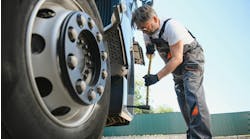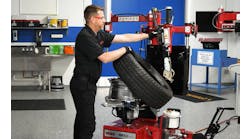Safety in vehicle shops, especially heavy duty truck repair shops, is an ongoing industry concern. One thing that will help create a safer shop environment is safe and correct vehicle and component lifting. Another is to make certain technicians are trained in the proper operation of all lifts and jacks used in a facility.
Vehicle lifting has grown more complicated because, as vehicles continue to evolve, they are becoming lighter and lower to the ground. As a consequence, lifting points are becoming harder to access.
Jacks And Stands
There are a variety of ways to safely lift vehicles and components. The most common way to lift a heavy duty vehicle is using a floor jack and vehicle support stands.
An essential thing to understand about using a floor jack is that it is only a lifting device. Floor jacks should not be used to support a vehicle while a technician works on it. This is a risk to technician safety, as jacks can fail.
While raising a truck with a floor jack, the operator should keep his/her body out from under the vehicle. The weight of a vehicle can cause serious injury or even death if improper and unsafe lifting techniques are used. It is not safe for a technician to go under the vehicle until it is properly supported by the correctly rated vehicle support stands.
Until the appropriate support stands are placed under a safe, OEM-recommended lifting point, the technician should minimize the amount of his/her body is under the vehicle.
To ensure a technician’s safety, each stand should have a rated capacity equal to or greater than the capacity of the device used to lift the vehicle. This will assure that the stands will not be overloaded.
Wheel Engaging Lifts
Wheel engaging lifts are another technique for safely lifting and supporting vehicles. Basically, these are air-operated lifting systems designed to be used in pairs to safely raise one end of a vehicle, or are electric-hydraulic lifting systems used to raise the entire vehicle, by cradling the tires and wheels.
One of the best attributes of a wheel engaging lift is it takes the difficult task of selecting a correct and safe lifting point away from the technician. These types of lifts – such as the Gray WL-20 or Gray WPLS series – can also function as a support stand, leaving the underside of the vehicle clear, creating an open and safer work environment.
The shop ceiling height or the type of work to be carried out can help determine which type of wheel engaging lift fits the operation.
Component Removal
The removal of truck components also creates safety concerns on the shop floor. Components weighing hundreds of pounds – such as transmissions, differentials, wheels and clutches – are routinely handled by technicians, and work-related low back pain and other injuries sometimes result.
Increasing the risk to technicians are such factors as:
- The load being too heavy or large, difficult to grasp or unstable.
- The task being too strenuous or involving awkward postures or movements.
- Lacking sufficient space in the working environment.
To ease the task of man-handling heavy truck components, lift equipment manufacturers offer a diverse selection of heavy duty jacks and specialized lift equipment expressly designed for component removal, installation and transportation. Here again, it is important that the correct equipment is used to safely and securely remove and install the components.
Other Points
The lifting and supporting of a vehicle or components is potentially the most dangerous activity in today’s shop. Understanding how to safely lift and support vehicles and components, along with using the correct equipment, is vitally important, as is proper routine equipment maintenance.
Moreover, technicians need to be sure that jacks and wheel lifts are in working order before using them. They should examine the equipment for obvious signs of wear, tear and structural damage. If damage is discovered, it should be repaired or, depending on the extent of the damage, the jack or wheel lift should be replaced.
Following industry standards and guidelines will help promote a safer shop.
Todd Michalski is vice president of sales and marketing for Gray Manufacturing Company (www.grayusa.com). A market leader in the lifting industry, it specializes in manufacturing and selling portable lifting equipment for use by professional mechanics.



